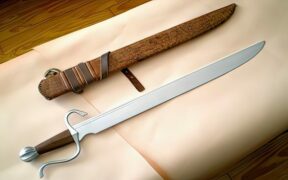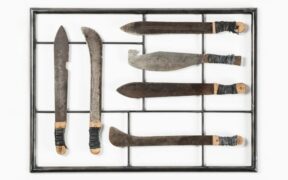Our content features commercial links to our products, committed to transparent, unbiased, and informed editorial recommendations. Learn More
Shotel Sword: Characteristics, Uses, and History
NO AI USED This Article has been written and edited by our team with no help of the AI
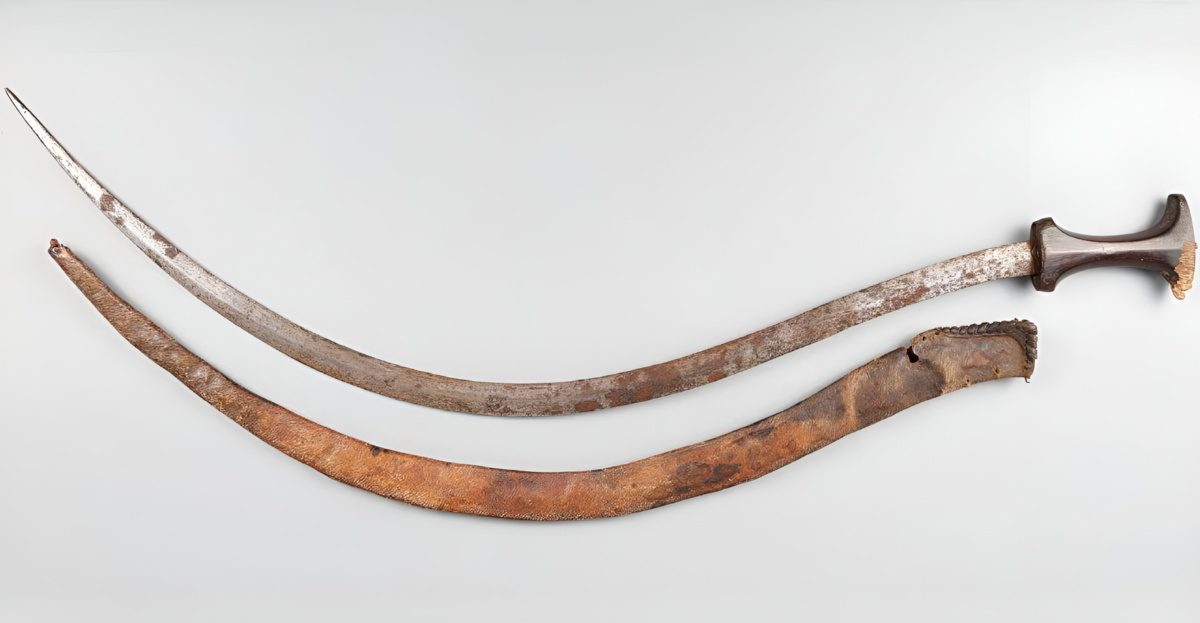
African swords are special because of their unique shapes and designs. One famous type is the Ethiopian Shotel.
This sword is different because it has a curved, sickle-shaped blade. This shape lets fighters use it in special ways and gives them an advantage in battles.
People often compare the Shotel to the curved Scimitar blade. It’s a popular sword in movies, games, and anime.
This article will explore the characteristics of Shotels, how it was used in fights, and its historical significance.
Characteristics of the Shotel Sword
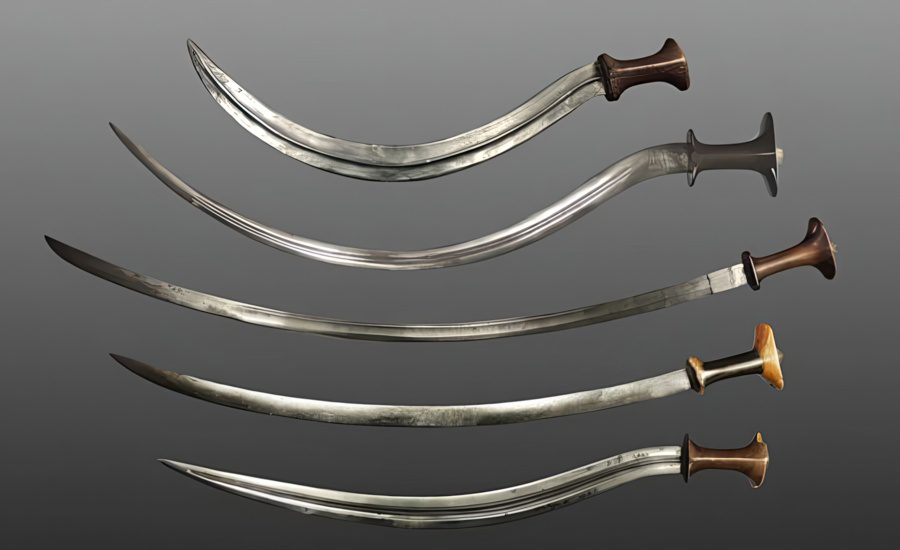
The Shotel is a sickle-shaped sword from Africa, available in many sizes and styles. It looks similar to the Persian Shamshir, mainly because of its deep inner curve.
The Shotel’s curve is special; it can start right from the handle or further up the blade, past the unsharpened part.
Throughout history, Shotels varied from slightly curved slashing swords to sharply curved sickles designed to bypass shields. The most typical Shotel falls somewhere in between, with a curved, sickle-like design.
There’s another sword called the Gurade, often confused with the Shotel. Unlike the Shotel, the Gurade has a curved blade but isn’t sickle-shaped. It was the main sabre used in Ethiopia.
Anatomy & Parts
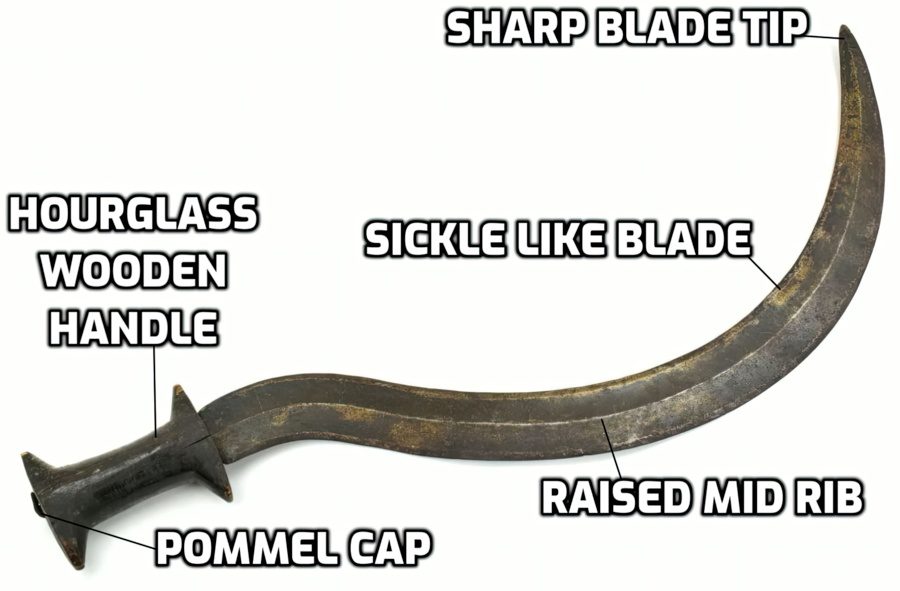
The Shotel is a sickle-like sword with one of the strongest and most visually prominent curves; its biggest characteristic sets it apart from many other swords. It is a curved sword that requires different dexterity when being used.
1. Blade
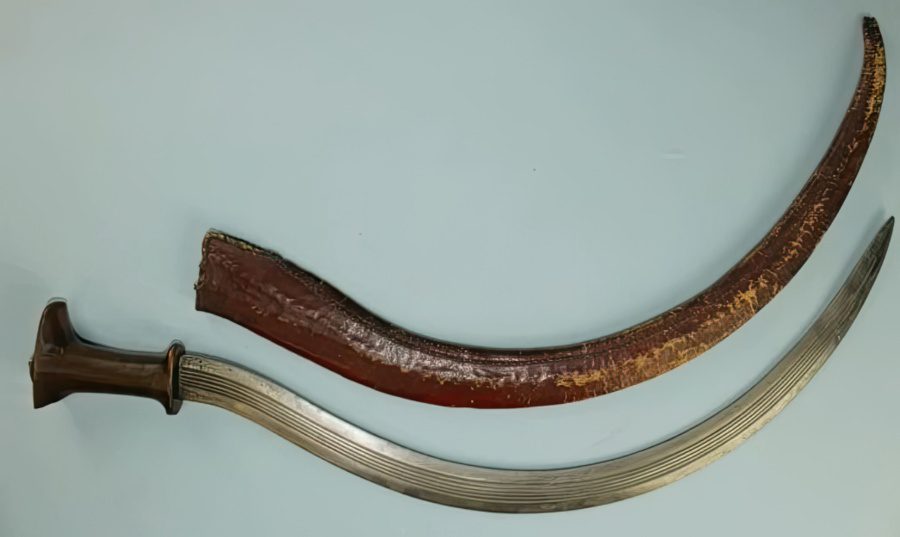
The Shotel’s blade is steel, shaped like a sickle, and often curves into a semi-circle.
It usually has two sharp edges, but sometimes only the inside edge is sharpened for slicing and chopping. Shotel blades vary in length from about 25.5 to 31 inches (65 to 80 cm).
The blade often features two wide grooves or a raised center line, making it look like a hollow diamond from the side. This design is not only nice to look at but also makes the blade lighter. This special shape might go all the way to the tip.
The blade starts with an unsharpened section near the handle, known as a ricasso, and ends with a very sharp, pointed tip designed for powerful stabbing attacks.
2. Guard
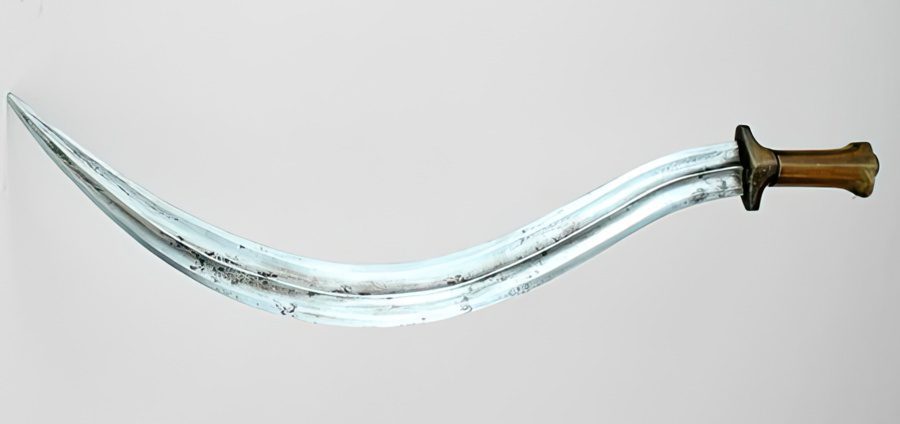
Shotel swords usually don’t have a proper guard. Sometimes, the top of the handle flares out into a disc shape, acting as a sort of guard, but it doesn’t protect the user’s hands like a crossguard does.
The Shotel often came with a large shield, which is one reason it lacks a true guard.
Additionally, the sword’s attack and defense movements, plus the flexibility and versatility required for its curved blade, would be restricted by a big crossguard.
3. Handle
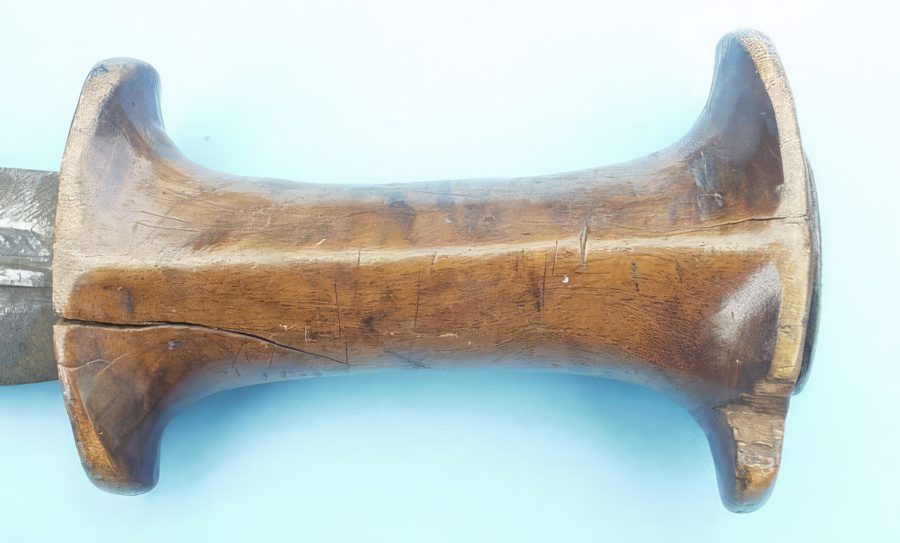
Shotel swords are one-handed weapons mainly because of their handle size and length, which averages around 4 to 6 inches (10 to 15 cm).
This is the exact proportion for only one hand to grasp it securely when carrying out the various attack motions of the long Shotel curved blade.
These handles are simple and usually made of wood in an hourglass shape, with the top and bottom being wider.
4. Pommel
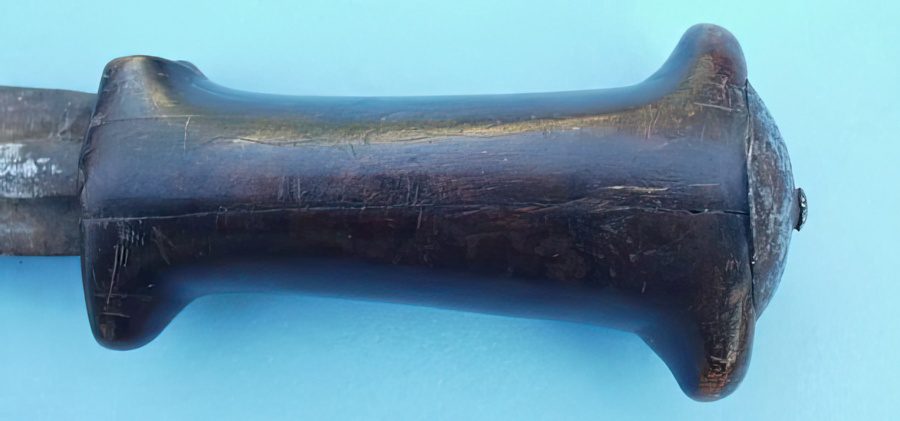
Some Shotel swords do not feature any guard or pommel, a metal piece on the bottom of the sword acts as a counterweight for the large length and hold the full-tang blade together.
There are rare cases, however, where a small brass disc or steel cap, which can even be engraved and decorated, is the sword’s pommel.
Scabbard
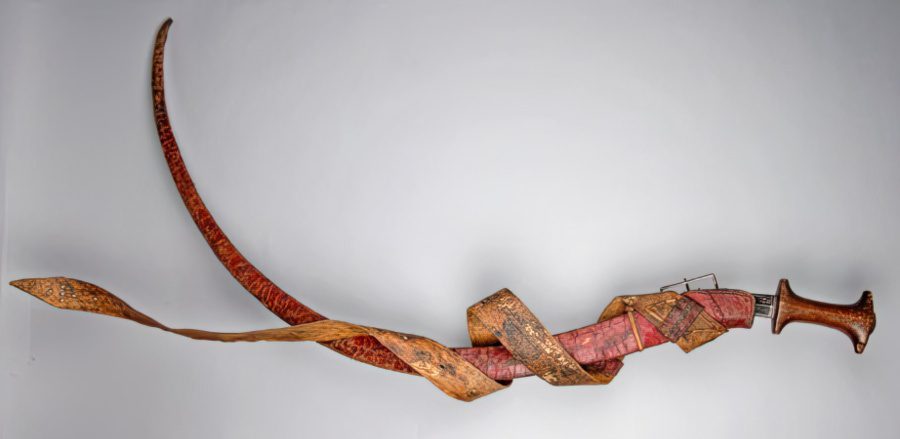
Shotel swords’ scabbards are often made of crafted leather and are a bit longer than the blade, looking like a tail on the person carrying it. This design means you have to twist your arm to draw the sword.
The Shotel was worn on either side of the body, attached to a belt. The scabbard’s tip is sharp, often decorated with gold and precious metals, and might have detailed designs, including braided spirals.
Weight
It was crucial that the weapon be lightweight and easily wielded, as it required fast and bizarre types of moves.
Depending on its length and size, a common weight for the Shotel sword is between 1.5 to 2 lbs (0.7 to 0.9 kg), making it a fairly light sword.
Size & Length
This Ethiopian sword can come in various lengths, from a very small, almost sickle-like tool to an extremely long and almost unwieldable massive sword.
Throughout history, Shotel swords that could be used effectively for combat and battle were around 31 to 40 inches (0.8 to 1 meter).
Uses for the Shotel Sword
The Shotel is a one-handed sword. It is primarily a weapon for puncturing and gouging the victim’s vital organ, especially if they were using a shield as a defense. This function is very similar to the European Falx sword.
The most important part about using the Shotel is the footwork and movement.
Because of its strong curve, the traditional style of fencing or sword fighting, like a Longsword, is not practiced. Instead, jumping and hopping around armed with a large shield using swift attacks is key.
Combat & Warfare
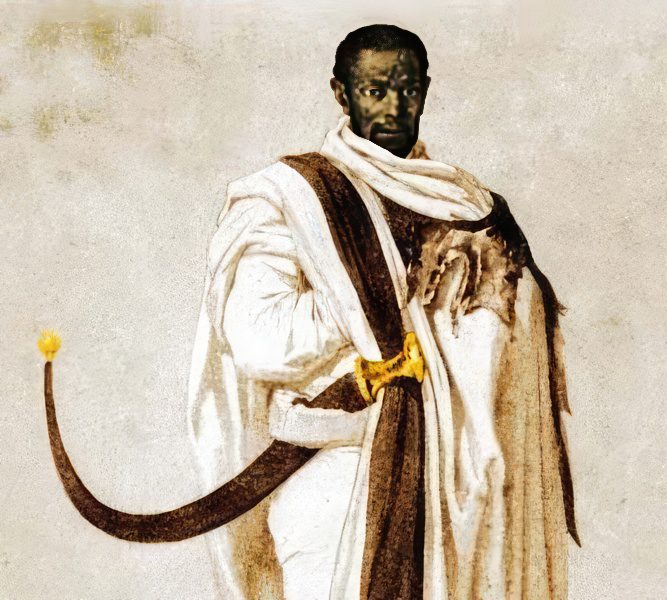
The Shotel, a sickle-shaped Ethiopian sword, was initially used for combat, warfare, and dueling. It required a lot of skill to use effectively, offering the advantage of unexpected attacks, though its use was somewhat limited.
Typically paired with a large shield, the Shotel was effective against cavalry, capable of hooking away enemy weapons or shields.
Despite the preference for swords like the Kaskara and Gudare in large battles, the Shotel was favored in duels for its emphasis on speed and agility. It was also effective in battle as a weapon for slashing and slicing, particularly against unarmored foes.
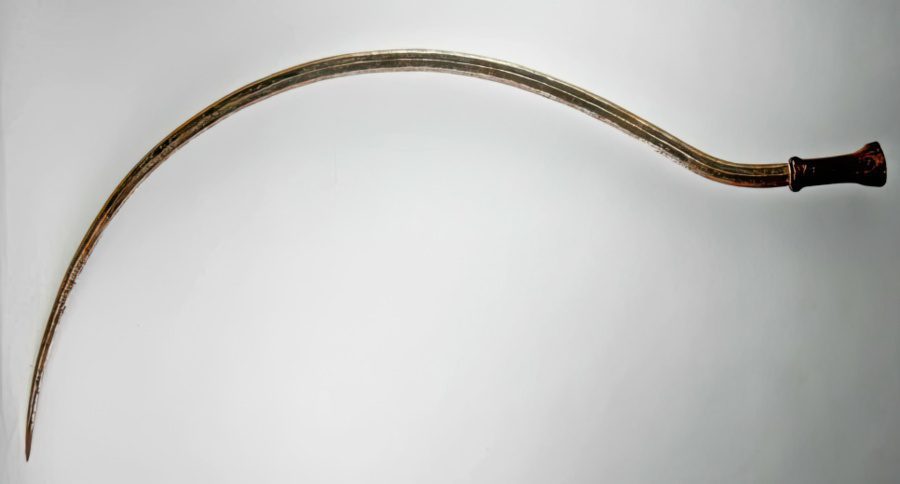
The Shotel appears in historical accounts as an effective weapon in specific situations. However, its curved design made it less suitable for large battles or against well-armed opponents.
“A great long Shotel with its silver ball,
Goes down with the women, and that’s all –
A first-rate sword with its silver knob,
Goes down with the women, that’s its job”
– Natives of Abyssinia, as told in the Journal of Royal United Service Institution
Before World War II, it was notably used in Italy for its cutting ability, similar to a Falchion, but struggled against straight or curved swords in almost all comparisons.
While there are references to the Shotel being used as an ornamental item by nobility and to attract attention, its practicality in battle is acknowledged.
Despite its effectiveness in certain contexts, it’s not considered among the strongest swords globally.
Ceremonial & Weapon of Rank
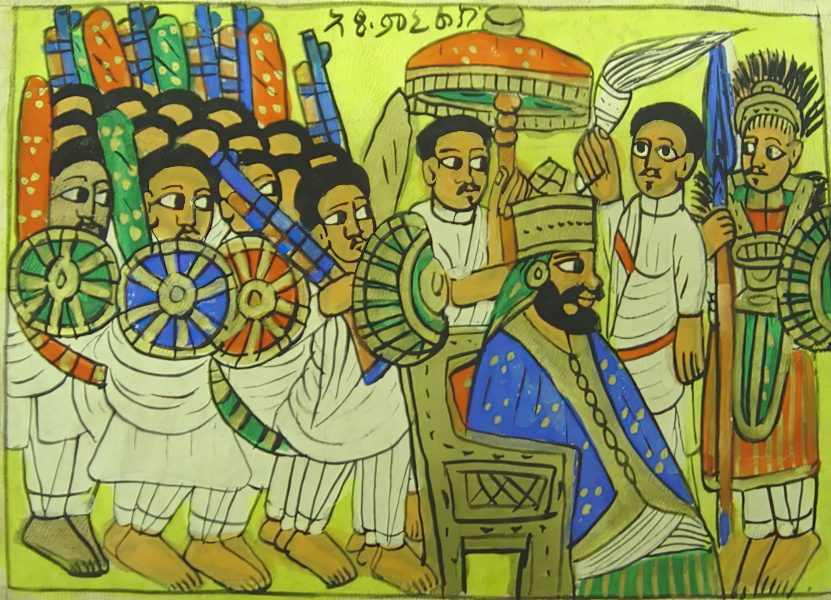
With time the Shotel sword became a highly ceremonial tool and as a piece to distinguish certain nobility or ranking figures from the rest of the populace.
Adding rare metals and having a pointy scabbard on its blades made it look like the tail of the person to impress others around them.
Modern Representations & Martial Arts
The Shotel sword, similar to the Katana and Ninja swords, is very popular today and often appears in anime, and video games like Elden Ring, Dark Souls, and Age of Empires. It’s usually depicted as a weapon for aggressive attacks and quick counter-moves.
The techniques of using the Shotel are widely practiced in Historical African Martial Arts (HAMA), focusing on its distinctive attack and defense styles.
Despite its fame in martial arts and traditional African sword dances, the Shotel’s curved blade makes it challenging for beginners to learn.
History of the Shotel Sword

The Shotel is a curved sword from the Ethiopian Empire, once called Abyssinia. It dates back to at least the 10th century BC, first used by the Damotian people.
It’s thought to have been influenced by the Khopesh Sword from ancient Mesopotamia and Egypt, brought to Ethiopia through ancient Nubia’s connections.
Another idea is that the Shotel came from the interactions of nomadic tribes along the trade routes by the Red Sea, particularly the Ethiopia Harar route.
It might have been inspired by the Gile, a throwing knife and short sword from Congo, used in Ethiopia and Kenya. Both the Shotel and Gile have similar features like the blade’s curve and handle.

The sword was a favorite among foot soldiers who also used shields. It was tough to use without lots of practice, so only experienced warriors could handle it well.
This led to the creation of special groups called the Meshenitai who were experts in using the Shotel sword. In the old days, these elite fighters were especially good at fighting cavalry and enemies without armor.
The Gurade was the main battle sword in Ethiopia, which made the Shotel more of a ceremonial item. However, it was still used in wars between Italy and Ethiopia in the 19th and 20th centuries.
